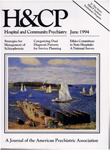Serious Mental Illness and Mortality Rates
Abstract
As has been found in a variety of other studies, the mortality rate for the seriously mentally ill population was more than twice the mortality rate for individuals in a comparable general population. Furthermore, although the increased mortality rate for the seriously mentally ill population was not constant across all causes of death, it was at least double that of the general population in seven of eight categories. The difference was greater for unnatural causes of death than for natural causes (SMRs=4.4 and 1.7, respectively), with the rates of deaths related to HIV showing the largest difference (SMR=6.1). The only cause of death that showed a greater(but nonsignificantly greater) rate in the general population was neoplasms (SMR=O.6).
The finding that the seriously mentally ill population has a higher mortality rate than the general population is of less importance than is future research to identify the underlying reasons for this heightened mortality risk. This research is necessary before we can explore strategies to reduce mortality rates.
A variety of alternative explanations for the high mortality rate in the seriously mentally ill population are possible. The high rate of alcohol and other drug use in this population can result in an increased incidence of death by both natural causes, such as liver and cardiac problems, and unnatural causes, such as accidents, suicide, and homicide. Substance abuse can also be hypothesized to contribute to increased HIV risk. We are also aware that confounding factors associated with the consequences of serious mental illness might help explain the high mortality rate. Such factors include lower socioeconomic status and fewer natural supports, which in turn result in increased vulnerability and risk for morbidity.
However, it is clear that even if we were to prevent suicide in the most vulnerable of seriously mentally ill patients, the susceptibility of death from a variety of other causes would remain remarkably high.
Access content
To read the fulltext, please use one of the options below to sign in or purchase access.- Personal login
- Institutional Login
- Sign in via OpenAthens
- Register for access
-
Please login/register if you wish to pair your device and check access availability.
Not a subscriber?
PsychiatryOnline subscription options offer access to the DSM-5 library, books, journals, CME, and patient resources. This all-in-one virtual library provides psychiatrists and mental health professionals with key resources for diagnosis, treatment, research, and professional development.
Need more help? PsychiatryOnline Customer Service may be reached by emailing [email protected] or by calling 800-368-5777 (in the U.S.) or 703-907-7322 (outside the U.S.).



